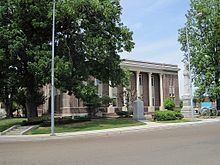Named for John Haywood Area 1,383 km² Population 18,224 (2013) | Founded 1823 | |
 | ||
Rivers Hatchie River, South Fork of the Forked Deer River | ||
Haywood county tennessee farm
Haywood County is a county located in the U.S. state of Tennessee. As of the 2010 census, the population was 18,787. Its county seat and largest city is Brownsville.
Contents
- Haywood county tennessee farm
- Map of Haywood County TN USA
- History
- Geography
- Adjacent counties
- National protected area
- Demographics
- Economy
- City
- Town
- Unincorporated communities
- Notable residents
- References
Map of Haywood County, TN, USA
History
Haywood County was created from part of Madison County in 1823–24, and was named for Tennessee judge and historian John Haywood. The state legislature designated Brownsville as the county seat. Haywood County was later reduced in size, when both Lauderdale and Crockett counties were created from its territory.
For much of the county's history, agriculture, especially growing cotton, was the basis of the local economy. Before the Civil War, this was accomplished by a plantation system based on the use of slave labor. After Emancipation in 1865, the plantations were largely broken up, and tenant farming and sharecropping became the way that people controlled their labor.
Geography
According to the U.S. Census Bureau, the county has a total area of 534 square miles (1,380 km2), of which 533 square miles (1,380 km2) is land and 0.9 square miles (2.3 km2) (0.2%) is water.
Haywood County is situated on the southeastern edge of the New Madrid Seismic Zone, an area with a high earthquake risk.
Adjacent counties
National protected area
Demographics
From 1940 to 1970, the county population declined. Many blacks left after confrontations and the murder of Elbert Williams in 1940 related to black attempts to register to vote. In addition, mechanization of agriculture reduced the need for farm workers, and other African Americans left as part of the second wave of the Great Migration. A total of more than five million migrated out of the south during those decades, moving especially to the West Coast for the expanding defense industry, and to industrial cities for work opportunities.
As of the 2010 United States Census, there were 18,787 people residing in the county. 50.4% were Black or African American, 45.9% White, 0.2% Native American, 0.1% Asian, 2.5% of some other race and 0.9% of two or more races. 3.8% were Hispanic or Latino (of any race).
As of the census of 2000, there were 19,797 people, 7,558 households, and 5,419 families residing in the county. The population density was 37 people per square mile (14/km²). There were 8,086 housing units at an average density of 15 per square mile (6/km²). The racial makeup of the county was 46.73% White, 51.05% Black or African American, 0.12% Native American, 0.09% Asian, 0.05% Pacific Islander, 1.38% from other races, and 0.58% from two or more races. 2.65% of the population were Hispanic or Latino of any race. Haywood and Shelby Counties are the only counties in Tennessee with a black majority.
There were 7,558 households out of which 33.40% had children under the age of 18 living with them, 45.80% were married couples living together, 22.00% had a female householder with no husband present, and 28.30% were non-families. 25.40% of all households were made up of individuals and 11.10% had someone living alone who was 65 years of age or older. The average household size was 2.59 and the average family size was 3.09.
In the county, the population was spread out with 27.20% under the age of 18, 9.80% from 18 to 24, 27.30% from 25 to 44, 21.90% from 45 to 64, and 13.80% who were 65 years of age or older. The median age was 35 years. For every 100 females there were 87.80 males. For every 100 females age 18 and over, there were 82.40 males.
The median income for a household in the county was $27,671, and the median income for a family was $32,597. Males had a median income of $27,333 versus $21,361 for females. The per capita income for the county was $14,669. About 16.30% of families and 19.50% of the population were below the poverty line, including 24.00% of those under age 18 and 25.70% of those age 65 or over.
Economy
The largest industry in Haywood County is agriculture. Haywood County grows more cotton that any other county in Tennessee and produced 189,000 bales in 2003 on 103,000 acres (420 km2). With its rich, fertile soil, the county's heritage began on the farm and several generations later, it remains on the farm. Soybeans are the county's #2 crop, followed by corn. Haywood County also has an abundance of flower and vegetable gardens in the area that provide everyone with fresh vegetables for their summertime pleasure and for canning or freezing. Haywood County also has fruit farms, and growers are more than happy to share their products with residents and visitors alike.
Agriculture and agri-related businesses contributed more than $130,000 million to the Haywood County economy in 2004.
In 2009, under the leadership of Tennessee Governor Phil Bredesen and Haywood County Mayor Franklin Smith, a 3,836-acre (1,552 ha) tract in southwestern Haywood County near Stanton was designated for a state-supported industrial "megasite," intended for a large-scale industrial or business development such as an automobile assembly plant. In September 2009, Tennessee's State Building Commission authorized spending of $40 million for purchase of the land.
City
Town
Unincorporated communities
Notable residents
One of Haywood County's most notable residents was Sleepy John Estes, a blues guitarist songwriter and vocalist. Born in 1899 or 1904 in Ripley, Tennessee, he lived most of his life in Brownsville. He died on June 5, 1977, in Brownsville. Sleepy John is buried at Elam Baptist Church Cemetery in Durhamville, Lauderdale County.
Other notable county residents include:
